The girls sat at their own table and were outstandingly well behaved. They've really been exceeding my expectations with that kind of thing lately. It was cool to look over at them, sitting across from each other, eating, chatting, swinging their feet, all by themselves, not grown up yet, but making a lot of progress.
Joe asked us questions and Eddie responded coherently and informatively. Until I hear the podcast, I'm going to assume that I spoke too fast, rambled on too long and forgot to say many important things. L'esprit d'escalier!
TNGA starts in less than a week though, Woohoo!
Post-interview, me, Ed and the girls drove up to Bull Mountain, or more precisely, the Turner Creek area. We've got some business to attend to up there. While marking the Fool's Gold route, Eddie and I both became concerned about how much wear the trails had sustained in the last year. He spent the better part of two days clearing drainages and nicking turns prior to the race, but he could only do so much. During the race it rained torrentially and riders reported enduring the worst conditions of their lives. Eddie talked to some forest service folks and some SORBA folks that have been involved with the work that's been done since the Bull/Jake Trail Assessment. A plan was worked up to reroute or repair some of the trails out there, some of that work has been done, some got postponed, some is scheduled for this fall. Nobody's been motivated to do too much maintenance until that work is done. Eddie and I are though, especially on the trails that we expect will remain open and especially on the ones at lower elevations that could have a more significant impact on the watershed.
But, before we jump out there swinging pickaxes. I'm not taking anyone's word for it. What is actually going on out there? Let's find out...
The Turner Creek Trail is a fast, flowing mile or so of singletrack running from FS28A near FS77 down to a food plot access road. Blogs and forum posts reported mud everywhere and generally terrible conditions on this trail, in particular. Every rider rode this section of the Fools Gold route. It seemed like a good place to start.
At the corner of FS28A, we noticed right away that water appeared to be flowing from the road down onto the trail. Prior to the Bull/Jake Assessment, under the assumption that volunteers would be responsible for maintenance on Bull/Jake going forward, the USFS got Woody Keen to teach a class on trail building and maintenance, including how to identify problems and what to do to fix them. I learned in that class that a soccer ball is a good analogue for water. Where the ball goes, water would go, generally. Where would the ball go?
Right down the trail.
Where would it stop?
At the very bottom of the hill, on the trail. The ball tries to get off the trail several times, but there's a little berm on the edge, holding it on. Water would do the same thing, picking up and carrying sediment down the descent, and dumping it when it stops. There are no tire tracks on the hill, the trail surface is solid there, but it's soft at the bottom from all the deposition. This is not the end of the world, any rider can manage this, but lets say last year it was solid and fast all over, and this year a rider rolls down the hill, hits the softness, loses speed, loses traction, leaves a track, has to climb the next hill and goes home compelled to troll for a flame war on the internets... "Bull Mountain sucks! Turner Creek used to be my favorite trail, but I got out there last week and it wasn't even rideable!" ...drawing the classic... "Sorry n00b, I guess Turner Creek isn't sanitized enough for you, some of us real mountain bikers like to ride real trails, maybe you should stick to the road, shaver!" ...and, of course, the even more classic... "Yeah, those f'n horses just tear up everything, who even let them on our trails?!" Then I read all this, lose faith in humanity and have to cry myself to sleep on my gigantic pillow.
We just can't be having that.
But I digress... our experiment revealed chaos at work. The ball doesn't always roll down the hill, even if you start it in the same spot.
We tried it several times. It was 50/50. I was pretty surprised the first time it didn't go down the hill, as you can hear in the vid.
Nicking the pile at the bottom would help; water wouldn't stop until it's off the trail. Deberming the hill would help even more; water would run off before it even hits the bottom. Neither is a permanent solution, but both are easy to do and would restore the character of the trail for many years. As we walked the trail, we realized that in general, the same solution applied to a lot of it. Deberm the hills, nick the bottoms.
But it wasn't that simple everywhere. This is the second hill.
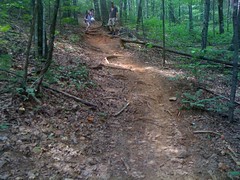
You can see the original line to the far left, and over the years, as the roots were exposed, the trail has crept to the right. At the bottom there's a relatively hard turn, deep with sand. There is a clear trail forming from this turn up to FS28A, presumably because this hill has become too dangerous for some horses. This is a fun descent and a challenging climb, but it's not sustainable. It's been changing, continues to change, has motivated the establishment of a user-created trail, and the sand at the bottom is lame. We didn't have a clinometer, but it's probably steeper than half the backslope. Water won't flow across the trail here, only down it. Deberming won't help. We played with the soccer ball all over this hill. Rolling dips in key spots would channel water off of the trail. Rock armoring would mitigate the erosion up around those roots. Short of a reroute, that's what we could do.
And there's this kind of thing...

This is a steep fall line trail that has worn in until it's below grade. It's stable at the top, on the hill it's loose, and predictably, at the bottom, there's another pile of sand. If I remember correctly, this is where the singletrack joins an old roadbed. From the other direction, the road continued down to the creek and the trail diverged to the left, straight up the hill before picking up the sidehill. The length of it could be armored with rock, or gravel. That's about it. Any repair on this hill will be a lot of work.
This hill is an example, though. A warning. Without some kind of attention, a couple of the hills out there will start looking more and more like this. Some faster than others, but we have an opportunity right now with most of them.
There were one or two places where the low spot between two hills crossed a dry prong. They were messier than other low spots:
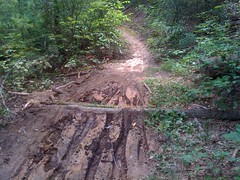
Can't nick them out, The trail would need to be built up with a bridge, a puncheon, rocks... sticks? People have been throwing sticks down for years. It looks terrible, but there are only a few of these, they're only bad after it's been raining and one of them does have a bridge. From a rideability perspective, I wouldn't mind leaving them alone, but they could be built up.
At a point, the old Turner Creek Trail diverges to the left and runs through a low, flat spot. I explored that trail last week. The newer trail continues along the contour, and appears to have been built with IMBA practices in mind, though I imagine it must have been built before they existed formally. This section of the trail was in pretty good shape.

It was outsloped with grade reversals. We even verified in several locations that it didn't even need to be debermed. Ideally, this is what water should do, roll right across the trail, even on a descent:
But, then when the old trail picked back up, we found another low spot with deposition:
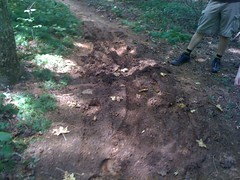
...and the responsible party.

So, occasionally, we'd run into a problem, but by and large, Turner Creek was like this:
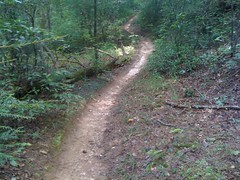
It may be hard to see in the photo, but this is a clean trail descending gradually to a messy low spot with another clean trail ascending gradually back out of it on the other side. Those low spots effect the biggest change in the experience of the trail between this year and last year. None of them were especially close to the creek and the terrain flattens out a lot between the trail and the creek, so I'd expect the environmental impact to be low, if measurable at all, but they're a little sketchy, they slow you down, and they look pretty bad. But on that note, I was surprised. They don't look THAT bad. I'm sure it looked really bad during and right after the race, but a week later, given that there were over a hundred cyclists on the trail in such epically bad conditions, surprisingly few tire tracks were still hanging around, and only in the low spots. If those low spots weren't built up so much, I don't think you'd be able to tell what kind or how much traffic the trail was getting at all.
So what should be done? Well, that depends on your philosophy and maybe your financial resources.
To make the trail hydrodynamically neutral and infinitely sustainable, you hire experts, do a soil analysis, determine the maximum slope based on it's shear strength and the average weight of a heavy horse and rider, go in with a clinometer, flag a new corridor, go back and pin flag the grade reversals, cut new trail with a Dingo, use the old trail where you can and elevate every dry prong crossing with stone until the new trail feels like FATS or Jackrabbit.
To make the trail feel like it "used to" for another 4 or 5 years without requiring much maintenance, I think you do the things I mentioned above and you monitor the bike/horse communities for "rules" vs. "sucks" comments to decide when to do them again.
To take the trail underground, you do nothing, let nature continue to take its course, let riders abandon the trail as it starts feeling lame to them and let more skilled or tolerant riders keep riding it. Eventually "Turner Creek sucks..." but a new equilibrium may form where the winter's duff never really wears away, the trail becomes perpetually armored with sort of a natural kevlar and after a couple of years, some of the ruts even heal, magically. People think Turner Creek sucks and forget where the trail head even is, but you know that it doesn't really suck any more and keep that secret close. It's happened before, but what's also happened before is trails just degrade until nobody can ride them, and we fall back and blame it on horses.
Choose!
Some rumors sort-of, maybe, kind-of allege that the 2010 Fools Gold itself is outright responsible for the plight of the Bull Mountain trails. The Bull/Jake Assessment provides evidence to the contrary, but so does direct inspection. This trail has never been used in a Fools Gold route, but it shows the same kind and level of wear as the roughest trails used by it, except maybe for lower Bull proper.
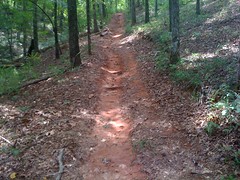
This is the connector from FS77 that leads down to the southern end of the Turner Creek Trail. Maybe it's technically part of the Turner Creek Trail proper but I always think of it as a connector. Go take a look, water runs down that channel on the left side for the length of the descent, steadily carrying the trail away with it. You can even make out an alternate line where people have started going to the right.
The runoff gets deposited in this corner...
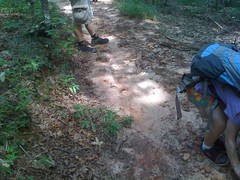
and fans out for a hundred yards into the woods below the trail.
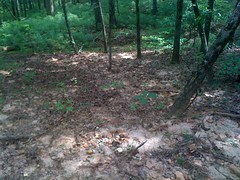
Oddly enough, as chunky as the downhill is, the corner is actually functioning, as predicted by the adage: "Turn the trail, not the water." Almost all of the sediment is getting carried off of the trail itself and down into the draw. There's no running water down there either, it's a dry prong. You can see that the underbrush is suffering though, not much grows in that sand. That's probably not good. With my luck, there's probably a rare trillium that once grew there.
That left hand sweeper leading from Turner Creek down to the roadbed is a bit of a mystery. Despite being a deep trench, it's smooth and clean for most of it's length until it gets a little rooty at the bottom. Clearly, water is running swiftly and directly down the trail, but the deposition at the bottom wasn't as bad as I expected. The remains of old rolling dips along its length could be repaired, assuming that's deemed necessary.
The doubletrack/roadbed was grassy and for the most part, pretty flat. I bet during the race it was muddy because it was so freakin' flat, but the soil doesn't go anywhere. It's just mud and it sits there. The soccer ball just sat there too. There were some small hills, with sand at the bottom. Being a road, there's not much we can do, though I'm not sure we'd really even want to.
I'd lost my glasses out there last week, breaking branches off of a downed tree and today I found them! I've lost multiple pairs of $150 Smiths, but these $25 Performance Bike dork goggles just keep coming back.
"F'n horses!":

Oh, wait, that's a bike-only trail showing exactly the kind of wear that people have argued all up in my face can only be caused by horses. I've seen it on hiking trails too, at Elachee. Water just does this when it runs over a root, or backfills a water bar, or something like that. This trail is on an old roadbed and runs kind of sideways down a hill from the road to a bridge across Turner Creek, but it's probably too steep (more than 1/2 the backslope) and has overwhelmed the rolling dips constructed in it. They could be repaired and they'd probably last a couple of years.
The USFS representative had mentioned to Eddie that after the Fools Gold, he was surprised, the only really bad spot he saw was here on the bike-only trail where silt had been flowing directly into the creek:
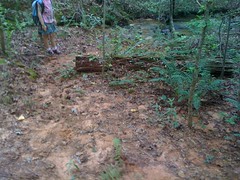
It looks like somebody put that log there as a silt trap and it's kind-of working. Getting water off the trail up the hill from here would work even better.
The Turner Creek Road Bypass looked a lot like the good section of the Turner Creek Trail. The ascent from the creek had the same problems as the descent, where it followed an old roadbed. Once the trail got off of the roadbed, it mostly just needed deberming and nicking. There was one boggy spot that could be built up and a short hill where the right side runs over rock, but the left is getting soggy. The left side could be armored, or blocked off.
We'd parked Ed's truck on FS28-1 and shuttled over to FS28A in my truck. Now, back at Eddie's truck we had to pile in and shuttle back to mine. He generally keeps the seats down though and fills the entire back with bike stuff, so it took a little work to make the back seat available for the kiddo's, but we got it done and headed back.
On the way back we decided that we had time to check out the Moss Branch Connector. We used it in the race too, and it's always been a rough trail. How would it have fared?
We parked at the ruins of the old game check station. No more Blue Ridge WMA, so no more game check station. They took the entire building, why would they leave these scraps behind?
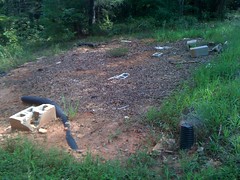
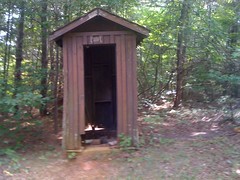
My theory is that it's cool to leave a little behind as artifacts for future generations. Some day it will be lost knowledge that there was a game check station here and somebody will puzzle over these remains as I have over the various rock walls and bricks I've found way up in the woods. That or they ran out of space in their open-top.
The Moss Branch Connector is busted, I suspect beyond repair.
Trenched out...
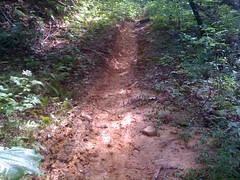
and here's where all that trench went.

Fall line climb/descent:
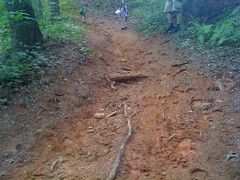
I have climbed that before. When it's dry, I can make it.
For the most part, the trail follows an old roadbed. There are ruts and runoff trenches all over. You'd need a bulldozer or a grader or something to fix it. Later on it gets more trail-like, but not entirely, until here:
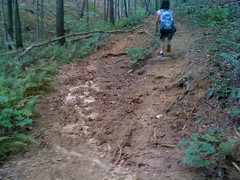
...where the old roadbed just dead-ends into a draw and what appears to be just a walked-in trail begins. By walked-in, I mean, I don't think any tools created this trail, horses just went that way for 50 years until there was a trail. Roots criscross from one side to the other every 8 inches, with no soil between them and exposed rock juts out all over the place. When it's dry, it's not unrideable, but it's not that fun either, at least not on a bike. It's short from there to the intersection with Jones Creek Ridge though.
We saw dung beetles having a ball (literally, heh) with some fresh horse droppings.

That pretty much fascinated the girls.
The Moss Branch Connector is the kind of trail that influences some people to categorically accuse equestrians of destroying trails and then accuse me of being a naive
It might be possible to fix the old roadbed with a bulldozer and the singletrack with a Dingo, but it would take that kind of work, and the really steep climbs would just get wrecked again in a year without being rerouted. I imagine it would be easier, cheaper and faster to cut your losses, close that trail and build a new, sustainable one.
We took Jones Creek Ridge and a connector back to Eddie's truck and shuttled back to my truck after that. The kids were wiped out. Sophie had been dragging back, even before we got on the Moss Branch Connector. They'd been helpful all day though, especially with the soccer ball. We drove up around the Winding Stair loop, backwards, collecting any leftover pink marking tape. Some guys were supposed to take it down, but they missed a lot.
On FS80, we ran into an older gentleman who'd double-flatted his truck. I gave him a ride home where he could patch his tire and get his wife to bring him back to his truck later. He lived off of Canada Creek Road. I'd driven, hiked and ridden past his house many times, and I'm sure I've even seen him in his yard and waved. I asked him about those red cherry trees with the smooth leaves. He had several growing across the street from his house. He said they were just wild cherries, and totally safe to eat. Really nice guy.
Finally, we went up around FS141 and examined the trail work Eddie'd done to the Black Falls Trail prior to the race. Some of it had been effective, some of his cuts were clear, some were completely filled in after just a week. Much of the trail there was fine, you couldn't tell anyone had ridden on it. One red clay hill though, leading right down to a creek, was still showing tread marks and would need some work.
It was a long day, but a long, interesting day. There's a contractor that's supposed to do some work in the fall, so we're hoping to find out what all's involved with that and go from there. We still need to take a look at Bull and Bare Hare, but they're lower priority. They have less impact on the watershed. Black Branch is certainly a problem, but it's supposed to get some kind of bulldozing, so we'll wait on that. Same for No-Tell. I'm not sure what the next steps will be, but I'm willing to put in some work days. Right now though, I'm ready to put in some sleep days. Zzzzz.



Excellent write up, thanks for doing the walk through and explaining what's going on !!
ReplyDeletewow! Good, insightful write-up. These kinds of problems will always occur on older trails. The type of construction just doesn't last without maintenance, especially if the trail gets even a moderate amount of traffic.
ReplyDelete